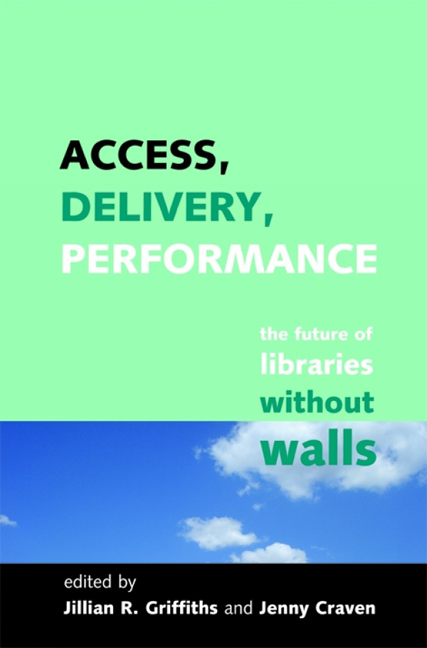Book contents
- Frontmatter
- Contents
- Contributors
- 1 Introduction
- 2 The Library Research Unit at the University of Lancaster, 1967–1972: a memoir
- Theme 1 Libraries, learning and distance learning
- Theme 2 Widening access to information
- Theme 3 Changing directions of information delivery
- 8 Institutional repositories in tertiary institutions: access, delivery and performance
- 9 Folksonomies to ontologies: the changing nature of controlled vocabularies
- Theme 4 Performance, quality and leadership
- Peter Brophy: a selected bibliography
- Index
8 - Institutional repositories in tertiary institutions: access, delivery and performance
from Theme 3 - Changing directions of information delivery
Published online by Cambridge University Press: 08 June 2018
- Frontmatter
- Contents
- Contributors
- 1 Introduction
- 2 The Library Research Unit at the University of Lancaster, 1967–1972: a memoir
- Theme 1 Libraries, learning and distance learning
- Theme 2 Widening access to information
- Theme 3 Changing directions of information delivery
- 8 Institutional repositories in tertiary institutions: access, delivery and performance
- 9 Folksonomies to ontologies: the changing nature of controlled vocabularies
- Theme 4 Performance, quality and leadership
- Peter Brophy: a selected bibliography
- Index
Summary
Introduction
Academic libraries have played a key role in the scholarly communication process for the past 150 years. They have experienced major changes in the creation, dissemination and preservation of knowledge, through changing social, philosophical and educational paradigms, and taken advantage of new technologies to fulfil their mission. Academic librarians have shown themselves to be adept at adjusting to these changes, and been proactive in advancing research, scholarship and knowledge. With the advent of institutional repositories, they are being asked to adopt another new technology, one that brings with it the potential for a further paradigm shift in scholarly communication. Roosendaal and Geurts (1997) identified four key functions of scientific/scholarly communication:
• registration: identifying the ‘owner’ of the intellectual property
• certification: establishing the quality of the research
• awareness: making the research available to others
• archiving: long-term preservation to make the results available to future researchers.
The first two have traditionally been carried out by hard copy scholarly journals, particularly registration (by tracking the date an article was submitted for publication) and certification (via the review process). Physical collections in libraries distributed the archiving function, and awareness was largely the responsibility of secondary sources, in particular abstracting and indexing services. Institutional repositories have the potential to change the way all four functions are carried out.
This chapter covers key concerns that led to the development of institutional repositories (IRs). This includes selected national and international initiatives, issues related to the creation, maintenance and use of repositories, and discussion of the extent to which IRs can meet the high expectations their promoters place on them.
History
In the late 20th century, existing channels for scholarly communication, particularly in the sciences and medicine, suffered from time lags in refereeing and publishing journal articles. Systems for distributing paper pre-prints by mail or facsimile were clumsy and slow, and researchers found it difficult to keep up with new developments in their fields. In the early 1990s, the rise of the internet and the web made other communication and publishing options possible, starting with e-mail distribution, then moving to the web. The first web-based pre-print server, arXiv, was started at Los Alamos National Laboratory in 1991. It initially accepted physics pre-prints, and has been extended to include aspects of mathematics, computational linguistics and neuroscience.
Information
- Type
- Chapter
- Information
- Access, Delivery, PerformanceThe Future of Libraries Without Walls, pp. 113 - 144Publisher: FacetPrint publication year: 2008
